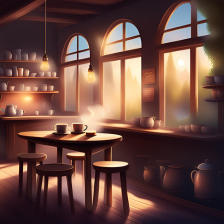WHAT IS THE CHARACTER OF ARABICA, AND HOW TEMPERAMENT IS ROBUSTA?
date
February 23, 2024.
category
blog
reading time
5 min
Did you know that the first discoveries of coffee are attributed to the Ethiopian shepherd Kaldi? Legend has it that sometime in the 9th century, Kaldi’s goats picked unknown berries from a nearby bush, which made them extremely energetic. After that, the shepherd himself tasted the fruits and had a similar, highly energizing experience. He shared his knowledge with a local priest who threw the fruits into a nearby fire, and very soon a strong aroma filled the room… This is how one of the most popular drinks in the world was born, which today is the basis of many cultures and traditions.
One of the first varieties of coffee cultivated in the world was Arabica (Coffea arabica), in Ethiopia, back in the 10th century. Its cultivation has spread all over the world and now accounts for a total of about 60 to 70 percent of the world’s coffee production.
Along with Arabica, one of the most widespread types of coffee is Robusta (Coffea canephora), which accounts for a smaller but significant share of world coffee production, as much as 30 to 40 percent.
Perhaps their dominance on the world coffee market is the reason why there are often debates about whether Arabica or Robusta is better. Since tastes are subjective, and what is best for one person may not be the best for another, often the outcome of this debate will remain unresolved.

However, differences arising from their different characteristics of taste, aroma and quality certainly exist.
Arabica coffee is often considered superior to Robusta because of its more complex flavors, gentler acidity and richer aromas. It can contain fruity, floral and chocolate notes, as well as other luxurious aromas. The taste of Arabica coffee is often described as delicate and balanced.
On the other hand, Robusta has a stronger, bitter taste and a less complex flavor profile. It can have earthy, nutty or even spicy notes. The flavor of Robusta is usually stronger compared to Arabica which has a sweeter, milder taste and will be a better choice for those who prefer milder and more balanced flavors.
Despite its flavor being considered less refined, Robusta is widely used in espresso blends because it is known to produce a better cream than Arabica.
Also, Robusta contains much more caffeine than Arabica coffee. Due to its high caffeine content, Robusta is popular among people who are looking for an energetic boost or want a stronger energy effect. But if you are careful with caffeine, the better choice for you will be Arabica, which contains almost half as much caffeine as Robusta. More precisely, the share of caffeine in Robusta is 2.7%, and in Arabica beans it is 1.5%.
Not only do coffee farmers work incredibly hard to produce perfect beans, but they also face many challenges during cultivation. This is especially true when it comes to Arabica, because this fragile plant requires almost ideal conditions in order to succeed: it grows at an altitude of between 600 and 2000 meters above sea level, it needs a mild climate with plenty of sunlight, but on the other hand, it must not be too hot. In addition, it is susceptible to various diseases and pests, such as scale, bacterial diseases or fungal infections. On the other hand, Robusta shows greater disease resistance, grows well at lower altitudes and thrives in areas where Arabica would be destroyed by fungi or other pests.
Precisely the demanding growing conditions are the reason why Arabica is usually more expensive than Robusta. That is why Robusta is often used in mass-produced products, such as instant coffee or espresso blends.
Therefore, the final decision on which coffee is better – Arabica or Robusta – depends on the individual’s personal taste preferences, needs and priorities. While some prefer the rich flavors of Arabica coffee, others may prefer the stronger taste and higher caffeine content of coffee from Robusta beans. It is important to experiment with different types of coffee to discover what works best for you…
An overview of the key differences between Arabica and Robusta:
Taste and aroma:
Arabica has a sweeter, softer taste and is often enriched with nuances of fruit, flowers, chocolate or nuts. It is often less acidic and not as bitter as Robusta.
Robusta is generally bitter and sharper for the taste buds. It is known for its strong taste with pronounced earthy notes. It often has more intense acidity compared to Arabica.
Acidity:
Arabica usually has a gentler acidity that can even enrich the flavor and add a bit of freshness.
Robusta tends to have a higher level of acidity, but it is not as complex as its Arabica rival.
Caffeine:
Arabica has less caffeine on average, usually between 1.2% to 1.5% caffeine per bean.
Robusta contains more caffeine on average, usually between 1.8% to 2.4% caffeine per bean.
Growing conditions:
Arabica requires specific climatic conditions to grow, including moderate temperature, high altitude and abundant rain. It is sensitive to many diseases and pests and requires more careful care. Arabica plants require more skilled manual labor during cultivation and processing.
Robusta can grow in various climatic conditions, it tolerates warmer temperatures and lower altitudes well. This coffee is more resistant to diseases and pests and can be grown on less sustainable terrain. The process of growing and processing Robusta is generally easier.
Cultivation area:
Arabica is most often grown in tropical areas with heavy rain, such as Ethiopia, Colombia, Brazil, Kenya, Costa Rica and others.
Robusta grows in tropical regions such as Uganda, Vietnam, India, Cameroon, Indonesia and others.
Price:
Arabica coffee is usually more expensive than Robusta coffee due to its complex flavors, more demanding growing conditions and lower yield per plant.
Robusta coffee is usually cheaper than Arabica coffee due to less demanding growing conditions and lower production costs, and it also has a higher yield per plant.










